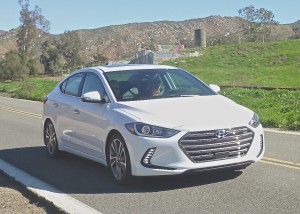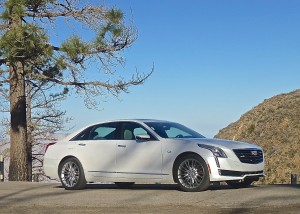New Elantra redesigned from strength
Filed under: Equinox, Autos

Hyundai’s Elantra won Car of the Year honors at its last redesign, and the new one is better throughout.
By John Gilbert
SAN DIEGO
Hyundai has been on an impressive upwardly-mobile roll ever since the 2011 model year, reaching levels of achievement in design and technology that couldn’t have been predicted. The Sonata has become a midsize mainstay, the Santa Fe and Tucson dependable entries in the sports-utility segments, the Genesis among sports-luxury sedans, the Accent as a subcompact, and the Veloster as a quirky specialty coupe.
There also is the compact Elantra, which was restyled for 2014, amid major upgrades to all the other vehicles coming from the South Korean manufacturer, and the Elantra surprised many even at Hyundai by winning the North American Car of the Year award in 2014, when it was last redesigned, right there among the world-class competition such as Civic, Mazda3, Corolla, Sentra and Jetta.
But now Hyundai has done it. The newest redesign of the compact Elantra for 2017 is so good it might be TOO good! I suggested to Hyundai officials that if the Sonata wasn’t one of my favorite vehicles in the automotive world, I would say the new Elantra is so good I’m not sure the Sonata is still needed.
The Sonata looks good, and the new Elantra looks like a slightly downsized Sonata, so the comparison begs to be made. A bit longer than the current model, considerably stiffer, stunning in its exterior restyling, and with driveability that is vastly improved in engine performance, steering and suspension, the new Elantra rates a “10” in every aspect, including a level of quietness that is startling for a compact. Read more
Cadillac CT6 comes up large in every way
Filed under: Equinox, Autos
By John Gilbert
LOS ANGELES
The refrain sounded similar: a luxury auto-builder claiming that it could build a car that was so advanced that it would be bigger, stronger, stiffer, wider, and better-performing than “the competition.”
The competition of large luxury cars always seems is the same German triumvirate — the Mercedes S-Class, the BMW 7-Series, and the Audi A8. And while the new claims are impressive, the refrain seems wearisome, because it simply doesn’t apply once you get the car on the road.
But this time it had a different sound, because the new contender is the Cadillac CT6. You’re excused if the alpha-numeric tendency of contemporary car-makers leaves you perpetually perplexed. If not, see if you can name and identify all the Toyota Scion models, but do it quickly, before the Scion line disappears. In this case, the CT6 has nothing to do with the CTS, except by surname.
The CT6 is Cadillac’s new big sedan, a worthy replacement for all those big land yachts Cadillac used to turn out, only this one is loaded up with cutting-edge technology from its platform to its suspension, to its unique-to-Cadillac twin-turbo, dual-overhead-camshaft 3.0-liter V6.
It was first described to us by a speaker with a distinct German accent. It was Johan DeNysschen, whose name might be familiar because he is the CEO of Cadillac these days, after holding similar titles at such august companies as Audi and Infiniti, where we learned that his cars and his companies rose to prominence just as he said they would.
And he knows the German competition. He was addressing the auto media assembled at The Level, a modern, trendy hotel in Los Angeles, chosen to give us all the feeling of how the new Cadillac CT6 would fit into life in the big city. But reality got in the way of logistics. Read more




 John Gilbert is a lifetime Minnesotan and career journalist, specializing in cars and sports during and since spending 30 years at the Minneapolis Tribune, now the Star Tribune. More recently, he has continued translating the high-tech world of autos and sharing his passionate insights as a freelance writer/photographer/broadcaster. A member of the prestigious North American Car and Truck of the Year jury since 1993. John can be heard Monday-Friday from 9-11am on 610 KDAL(www.kdal610.com) on the "John Gilbert Show," and writes a column in the Duluth Reader.
John Gilbert is a lifetime Minnesotan and career journalist, specializing in cars and sports during and since spending 30 years at the Minneapolis Tribune, now the Star Tribune. More recently, he has continued translating the high-tech world of autos and sharing his passionate insights as a freelance writer/photographer/broadcaster. A member of the prestigious North American Car and Truck of the Year jury since 1993. John can be heard Monday-Friday from 9-11am on 610 KDAL(www.kdal610.com) on the "John Gilbert Show," and writes a column in the Duluth Reader.